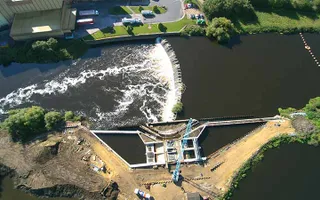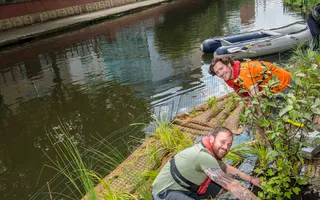Flowing water can generate low-cost, clean energy. Our hydropower plant at Knottingley supplies continuous power to a local flour mill, making your daily loaf low carbon too.
As owners of Knottingly weir and the land beside it, we went into partnership with Barn Energy, a firm dedicated to developing the hydropower sector across the UK, backed by private investors. A company called Northern Hydropower was set up in 2016 to build and operate the plant.
Commissioned in 2017, it has now been in continuous operation ever since, generating electricity 24 hours a day, 365 days a year. Most of the supply goes to the huge ADM Flour Mill nearby, which also runs round the clock, so has a constant need for power.
As independent consultant, civil engineer and part of the scheme's design team, Austin Flather explains: “The problem with wind is that it is intermittent. If it doesn't blow, you don't get any power. But at Knottingley, I don't think we've had a single day where we haven't generated due to lack of water. Water flows into the Aire & Calder from a huge area of Yorkshire, which ensures water passes over the weir pretty much continuously.
"Over the last year, the plant has generated around 2.8 gigawatt hours of electricity, which means something in the region of 700-800 homes could be taken totally off-grid by the power it generates.”
Together with Barn Energy, our colleagues looked at a number of weirs across our network as potential sites for hydropower schemes. A winning combination of high water flow rates, accessible land and having a potential customer for the energy right on the doorstep, made Knottingley very attractive.
Clean, affordable energy
Austin adds: “When we began talking to ADM Flour Mills, it quickly became obvious that there was a ‘win-win' here at Knottingley. The mill benefitted greatly from taking clean, affordable energy from the plant and the plant has a dedicated customer that meant it wasn't so dependent on feeding electricity into the National Grid.”
There are benefits for our charity too. Utilities business manager, Sam O'Neil says: “We earn an income, with a percentage share of the profits Northern Hydropower make from the scheme. That helps us reinvest in and maintain our waterways. But one of the biggest benefits is that a huge ‘fish pass' was also built into the scheme. These are structures that help breeding fish, travelling up the river to their spawning grounds, bypass the weir that would otherwise block their way. As the project incorporated a fish pass, it saved our charity around £800,000, which is how much it would have cost us to build the fish pass alone.”
Another 10 schemes on the table
An obvious question is: why don't we have more of these schemes? As Sam explains, it's not for lack of trying: “We've actually got another 10 schemes on the table, fully consented, ready to go. The issue is one of economics. At Knottingley, we had a handy customer on site. But in other places the schemes depend on the price we get to feed electricity into the National Grid. At the moment, the price isn't high enough and the numbers simply don't add up to justify the investment in building the plant in the first place. What we need is a subsidy or support from the government to make it even more viable. Hydropower can't solve our energy problems alone. But it can be part of a mixed solution.”
As hydropower schemes like this can last a century, there's plenty of time in the future to pay back any investment made in hydropower today. As the UK works towards reaching net-zero greenhouse gas emissions by 2050, we hope this type of longer-term thinking can be implemented on a greater scale, and that our canals and rivers can do more and more to protect our planet.






